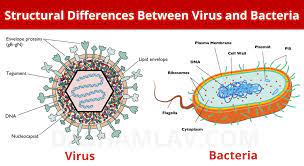When I started teaching microbiology at the University of Mississippi ten years ago, I realized that many students found it hard to distinguish some microscopic organisms.
We did research as a department and came up with teaching techniques that made the work of learners look easier. I came up with a list of differences between various microscopic organisms.
So, what is the main difference between bacteria and viruses? The former are living things that can reproduce independently whereas the latter are non-living things that rely on the host cell for replication.
Understanding the difference between bacteria and viruses is crucial in the preparation of a microbiology exam. Continue reading this article for further explanation and differences.

Comparison Table (Bacteria vs Virus)
| Basic Terms | Bacteria | Viruses |
| Size | Larger (1000 nm) | Smaller (20-400 nm) |
| Cell Type | Prokaryotic cells | Acellular |
| Number of Cell | Single-cell | No cell |
| Microscopy | Visible under light microscope | Visible under an electron microscope |
| Shape | Cocci have a spherical shape
Bacilli have rod-shape Spiral and vibrio have comma shape |
Have spherical shapes, rod-shaped, helical shapes.
Some viruses like bacteriophages have complex shapes |
| Cellular Machinery | Present | Absent |
| Type of organism | Intercellular organism and some are intracellular organisms | Strictly intracellular organism |
| Structure | Organelles and genetic materials are enveloped by the cell wall. | Genetic materials are enclosed in the capsid. Other have a cell membrane. |
| Cell wall | Present | Absent |
| Cell membrane | Present in some bacteria | Absent |
| Genome | DNA and RNA
1 chromosome No histones |
DNA or RNA
1 nucleocapsid except in segmented or diploid viruses |
| Nucleic acid | Floating freely in the cytoplasm | Enclosed inside a protein coat |
| mRNA | Mono- and poly-cistronic mRNA | Some have poly-cistronic mRNA and post-translational cleavage. |
| Cell organelles | Present. But are non-membrane bound. | Absent |
| Ribosomes | 70s ribosomes (30s+50s) | Absent |
| Living attributes | Living organism | Both living and non-living organism |
| Replication | Binary fission or asexual reproduction. | Invade the host cell for replication. |
| Reproduction | Able to reproduced independently | Depend on living cell for reproduction |
| Other forms | Spore forming bacteria | Viroids and Prions |
| Cell infected | Animal, Plant, Fungi | Animal, Plant, Protozoa, Fungi, Bacteria, Archaea |
| Infection | Localized | Systemic |
| Induction of fever | Bacterial disease causes fever | May or may not cause fever |
| Illness duration | Can last more than 10 days | Can last between two to ten days. |
| Diseases | Food poisoning, gastritis, and ulcers, meningitis, pneumonia. | AIDS, common cold, influenza, chickenpox |
| Susceptibility to Antibiotics | Prone to antibiotics | Do not respond to antibiotics |
| Treatment | Antibiotics | Antiviral drugs |
| Significance | Flora, prebiotics, and fermenters are useful | Ideal in genetic engineering. |
| Metabolism | Within the cell | Viruses do not metabolize |
| Incubation | Within 1 to 2 weeks | Within few days to two weeks |
| Examples | E. coli, Salmonella spp., Listeria spp., Mycobacteria spp., Staphylococcus spp., Bacillus anthracis, etc. | HIV, Hepatitis A virus, Rhino Virus, Ebola virus, etc. |
What Are Bacteria?
Bacteria are prokaryotes found in the ecosystem. These unicellular organisms can grow in harsh conditions such as hot springs.
Bacteria are classified according to morphological structures. Cocci have a spherical shape, bacilli have rod-shaped, vibrio has comma shape and spirilla has a spiral shape.
Bacteria are surrounded by cell membranes. The cell membrane encloses the cytoplasm that contains nutrients, DNA, proteins, and other essential components.
Bacteria contain non-membrane-bound organelles. Proteins are transported by the cytoskeleton and have circular chromosomes in the nucleoid.
Bacteria are either heterotrophs or autotrophs. The carbon source is the carbon dioxide in autotrophs and organic compounds in heterotrophs.
What Is Virus?
Viruses are non-living things. The genetic material is representing as either DNA or RNA enclosed by the protein core. These viruses infect the life of animals, plants, bacteria, and archaea.
Virion is a complex virus with genetic material covered by capsid. The capsid is a protective protein coat encoded by the viral genome.
Examples of viruses’ groups are dsDNA viruses, ssDNA viruses, dsRNA viruses, dsRNA viruses, (+) ss RNA viruses, (-) ss RNA viruses, ssRNA-RT viruses, and dsDNA-Rt viruses.
The main orders of viruses include Caudovirales, Herpesvirales, Ligamenvirales, Mononegavirales, Nidovirales, Picornavirales, and Tymovirales.
Main Differences between Bacteria and Virus
- Bacteria reproduce independently whereas viruses need host cells for reproduction.
- Bacteria are living things whereas viruses are non-living things.
- Bacteria are larger while viruses are smaller
- Bacteria contain cell walls whereas viruses lack a cell walls.
- Bacteria have circular chromosomes whereas viruses have DNA or RNA strand.
- Bacteria have ribosomes while viruses lack ribosomes.
- Bacteria experience metabolism within the cell whereas viruses do not experience metabolisms.
- Bacteria are cellular machinery while viruses are non-cellular machinery
- Bacteria are either beneficial or harmful while viruses are harmful to life.
- Bacteria cause localized infection whereas viruses cause systemic infection
Similarities between Bacteria and Virus
- Both cause infection
- Both have a harmful effect
- Both can be prevented
In Conclusion
The main difference between bacteria and viruses is that the former is larger and can reproduce independently while the latter is smaller and depend on the host cell for reproduction.
Both bacterial and viral infections can be prevented. Bacteria can be prevented by the use of antibiotics and viruses through vaccination.
More Sources and References
- https://www.mayoclinic.org/diseases-conditions/infectious-diseases/expert-answers/infectious-disease/faq-20058098
- https://www.webmd.com/a-to-z-guides/qa/how-do-viruses-differ-from-bacteria
- https://www.webmd.com/a-to-z-guides/bacterial-and-viral-infections
- https://www.healthline.com/health/bacterial-vs-viral-infections